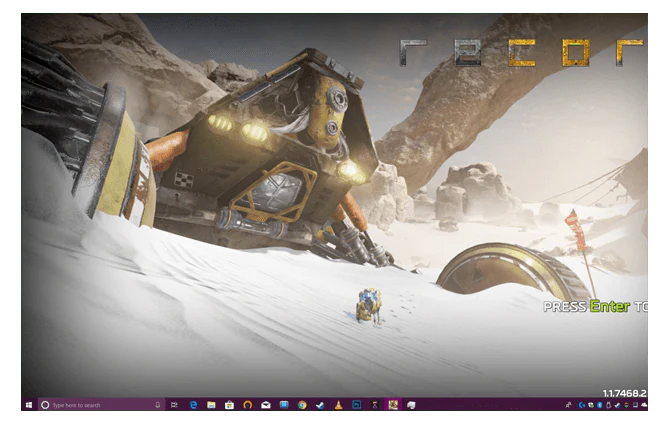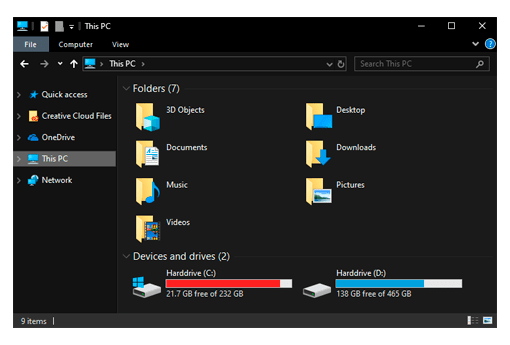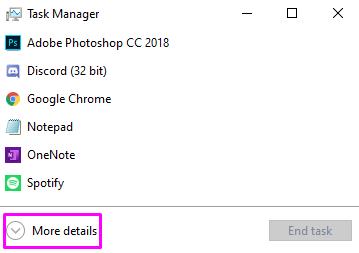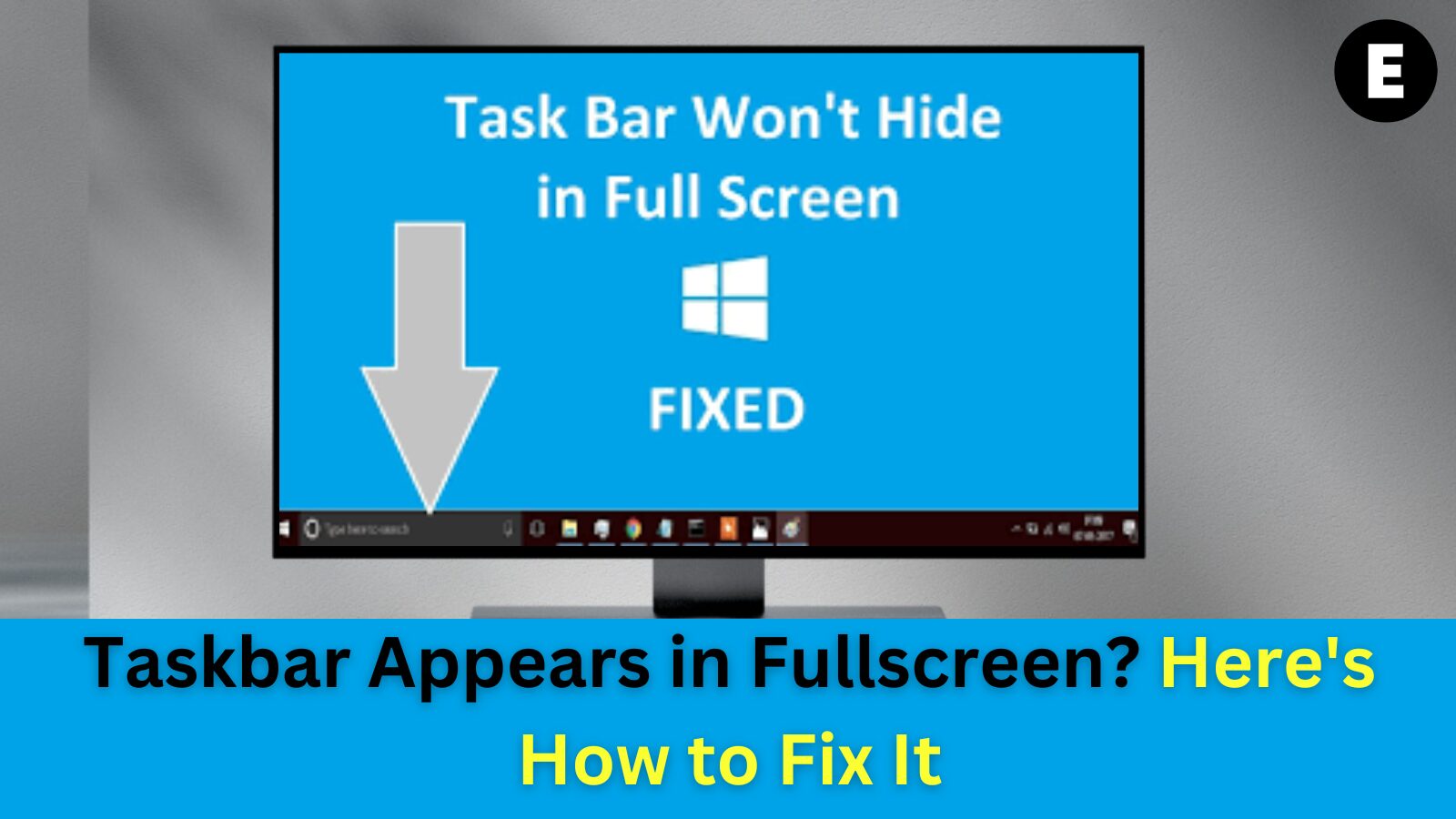The issue of the taskbar appearing in fullscreen while playing games, watching YouTube videos, or browsing the web (such as in Chrome or Firefox) is a common problem among Windows users. This bug has been around since Windows 7 and continues to affect many today.
By default, your taskbar sits at the bottom of the screen and contains essential features like the Windows Start menu, system clock, volume manager, and network settings. It also displays the applications that are currently open and running.
When you’re watching a video, playing a game, or working in a fullscreen document or website, the taskbar should automatically hide.
Having the taskbar overlaying in these situations can be distracting and frustrating. It can block important elements of what you’re trying to view, whether it’s in a video, game, or document.

Taskbar Not Hiding in Fullscreen? Quick Solutions
If your taskbar appears while you’re in fullscreen mode, there are a few quick fixes you can try.
- Right-click on any taskbar icon (such as an application, network status, or volume control), then click back into the video, game, or web browser you’re viewing. This may resolve the issue, especially with games.
- For Windows 7, try forcing the taskbar to hide by exiting fullscreen, then clicking the show desktop button in the taskbar twice. This will minimize and maximize all open windows. After that, check if the taskbar disappears when you enter fullscreen again.
- If you’re using Windows 10, this simple fix should work:
- Press Ctrl+Shift+Esc to open the Task Manager.
- On the Processes tab, scroll down and select Windows Explorer.
- Click the Restart button in the bottom-right corner of the Task Manager.
If these quick fixes don’t resolve the issue, continue reading to understand why your taskbar is showing in fullscreen mode and learn how to permanently fix it.
What is Windows Explorer and How to Restart It to Fix Taskbar Issues
To many users, Windows Explorer may seem like an integral part of the Windows operating system, but in reality, it’s an independent application running within the system.
Whenever you access your files or browse through the contents of your hard drive, you’re using Windows Explorer. Essentially, it serves as the graphical user interface (GUI) for managing your files.
Windows Explorer is closely linked to the taskbar, as the taskbar is essentially an extension of this application.
Sometimes, after a Windows update, Windows Explorer might freeze or stall, leading to various issues, such as the taskbar not hiding in fullscreen mode. This can happen while gaming, watching YouTube videos, or browsing the web.
Restarting Windows Explorer to Fix Taskbar Issues

If your taskbar is not hiding properly, restarting Windows Explorer can often resolve the issue.
Here’s how to restart Windows Explorer on Windows 10:
- Open the Task Manager in one of two ways:
- Right-click on your taskbar and select Task Manager.
- Press Ctrl + Alt + Del on your keyboard, then select Task Manager from the Security Options screen.
- You’ll see all the apps and processes running on your computer. If the Task Manager is in compact mode, click More Details to expand it.

- Scroll through the list of processes to find Windows Explorer and click to select it.

- Restart Windows Explorer by either:
- Clicking the Restart button at the bottom-right corner of the Task Manager window.

- Right-clicking the Windows Explorer process and selecting Restart.

After restarting, your taskbar and Windows Explorer windows will briefly disappear as the system resets and reopens the app.
This quick fix can solve many taskbar-related issues that arise after a Windows update or other system glitches.
How to Restart Windows Explorer on Windows 7 to Fix Taskbar Issues
Restarting Windows Explorer in Windows 7 involves a few additional steps compared to newer versions. If you’re facing issues with your taskbar, such as it not hiding in fullscreen mode, restarting Windows Explorer can help resolve the problem.
Here’s how to restart Windows Explorer on Windows 7:
- Open the Task Manager using one of these methods:
- Right-click on the taskbar and select Start Task Manager.
- Press Ctrl + Alt + Del on your keyboard at the same time.
- Once the Task Manager is open, switch to the Processes tab.
- Find explorer.exe in the list, then right-click on it.
- Select End Process and confirm by clicking End Process again. Your taskbar and desktop icons will temporarily disappear, but make sure to keep Task Manager open.
- Now, click File, then New Task (Run…).
- Type explorer.exe in the field and click OK.
After following these steps, Windows Explorer will restart, and your taskbar will reappear. You can repeat this process whenever necessary. Restarting Windows Explorer does not harm your system and can resolve various taskbar-related issues across all versions of Windows.
Once you’ve restarted Windows Explorer, check if the issue with your taskbar not hiding in fullscreen has been resolved. If not, continue reading for additional solutions.
Adjusting Taskbar Settings and Enabling AutoHide
Windows offers a range of customization options, including the ability to adjust taskbar settings. Sometimes, these settings can get misconfigured, which can cause the taskbar to behave unpredictably. If your taskbar isn’t working as expected, checking and adjusting the settings might help.
You can change the taskbar’s appearance, such as moving it to different parts of the screen or adjusting its size and color. Additionally, there are more advanced settings, like enabling AutoHide, which hides the taskbar when it’s not in use.
If you want to enable AutoHide or adjust other taskbar settings, follow these steps based on your operating system:
How to Auto-Hide the Taskbar on Windows 10
To enable auto-hide for the taskbar in Windows 10, follow these simple steps:
- Open the Settings app in one of two ways:
- Click on the Windows logo in the bottom left of your screen, then select Settings (gear icon).
- Alternatively, press the Windows and I keys simultaneously on your keyboard.
- Select Personalization.
- In the left menu, click on Taskbar.
In Windows 10, there are two options to enable auto-hide for the taskbar:
- Automatically hide the taskbar in desktop mode
- Automatically hide the taskbar in tablet mode
To activate these options, simply toggle the slider for each one. This will typically resolve issues where the taskbar fails to hide in fullscreen mode.
If the issue persists, you can adjust additional taskbar settings in this menu. If the problem reoccurs, return to these settings to ensure they remain configured correctly.
How to Auto-Hide the Taskbar on Windows 7
Follow these steps to enable auto-hide for the taskbar in Windows 7:
- Right-click on an empty area of the taskbar.

- Select Properties.
- Choose the Taskbar tab.
- Under Taskbar appearance, find the option labeled Auto-hide the taskbar. By default, this is not enabled.
To enable it, check the box next to Auto-hide the taskbar. Click Apply, then OK to save your changes.
As with Windows 10, you can adjust other taskbar settings in this menu. If the taskbar continues to show when it shouldn’t, revisit these settings to ensure they haven’t been altered.
What to Do if Auto-Hide Doesn’t Work
If auto-hide doesn’t work, the issue is likely caused by a running application or service. Some programs, especially those with dynamic icons or notifications, can prevent the taskbar from hiding.
For example, an application that updates its icon or status frequently can trigger a notification to the taskbar, causing it to remain visible.
To resolve this, check your active apps and close them one by one to identify which one is causing the issue. Once the culprit is found, closing it should allow your taskbar to auto-hide properly.
One more thing
If you’re in search of a software company that embodies integrity and upholds honest business practices, your quest ends here at Ecomkeys.com. As a Microsoft Certified Partner, we prioritize the trust and satisfaction of our customers. Our commitment to delivering reliable software products is unwavering, and our dedication to your experience extends far beyond the point of sale. At Ecomkeys.com, we provide a comprehensive 360-degree support system that accompanies you throughout your software journey. Your trust is our foundation, and we’re here to ensure that every interaction with us is a positive and trustworthy one.

